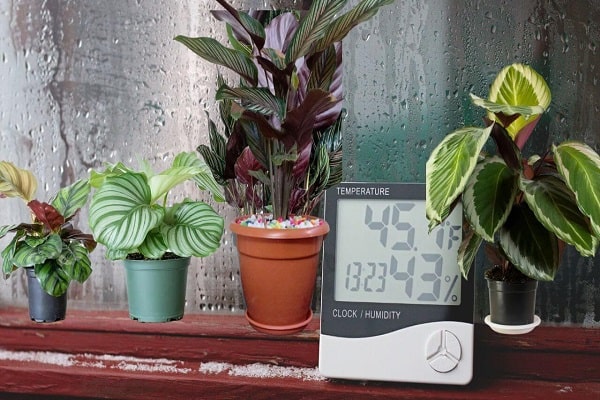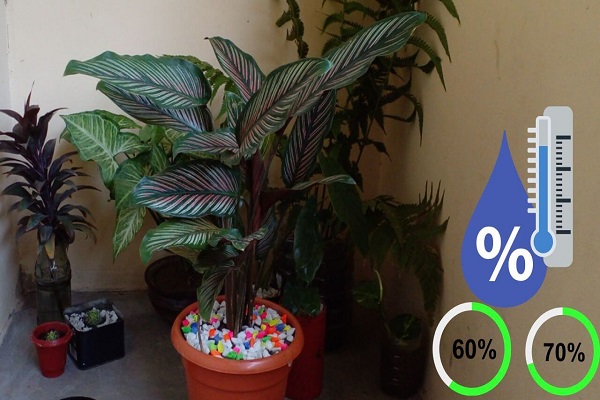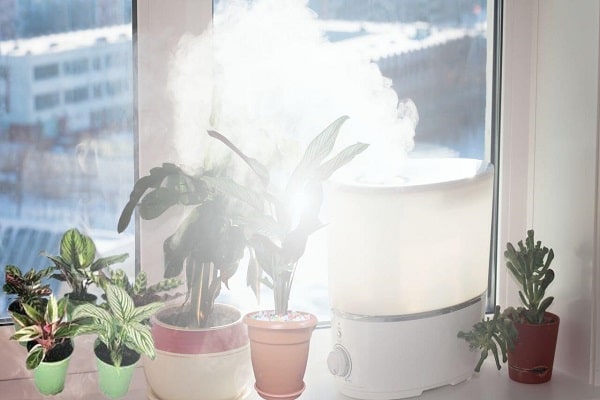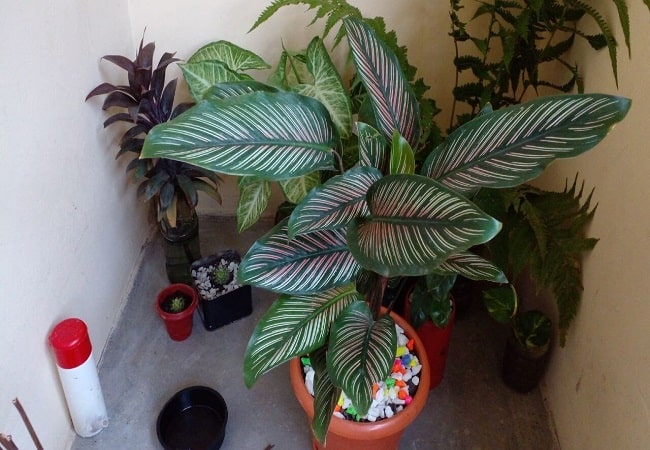Calathea houseplants are popular with many people because of their beautiful foliage. But did you know that Calathea houseplants are also sensitive to humidity levels? That’s That’s right! The wrong humidity level can cause Calathea leaves to be brown and drop off. So, what is the best humidity for Calathea houseplants?
In this article, I will discuss why humidity is so important for Calathea and provide tips on providing the right humidity level for your plant. I will also suggest a few ways to increase humidity around your Calathea houseplant if it is struggling. If you want to buy or take in a Calathea, read this article first.
Quick Navigation
Why Does Calathea Need So Much Humidity

Plants stay healthy by keeping a delicate balance with the rest of the world. So that they can get water from their roots, plants release water vapor through holes in their leaves called stomata. The tiny amount of suction made by the water molecules moving away helps pull up more water. It looks like the air is drinking through the straw-like stems of the plant.
The process by which leaves lose water is called transpiration, and you should look for a plant’s health under normal conditions. But if something upsets the balance and the leaves lose water faster than the roots can replace, the leaf cells dry out, wither, and die. Low humidity is a good example because dry air pulls water vapor from leaves much more quickly than moist air.
Some plants have thick leaves that store a lot of water to protect themselves from this effect. The plump leaves of succulents are a good example of this. This is not a defense for Calatheas. They grew up in wet, misty jungles where they rarely ran out of water, so their leaves are very thin. The leaves will dry out quickly if something too much speeds up the transpiration rate.
What Is Humidity Level Good For Calathea

Regarding the humidity levels for calathea, experts generally recommend between 60 and 80 percent. This is because high humidity helps keep the plant moist and healthy. In contrast, a low humidity level can cause problems like fungus growth. You must remember that to note that different plants need different levels of humidity.
Too low of a humidity level can cause the plant to dry out, while too high of a humidity level can cause the plant to overheat. You should monitor the humidity levels of your calathea at all times and adjust as needed.
Best Humidity For Calathea
There are many ways to increase humidity for your calathea. Still, the best way may vary depending on the plant’s environment. When increasing humidity, you must consider both external and internal factors.
The amount of rain and wind are external factors, while a plant’s size and how well it is watered are examples of internal factors.
There is a big difference between how well these different methods work. We’llWe’ll start with the most useful and then move on to the other most common strategies:
Using Plant Humidifier

A plant humidifier is an excellent way to increase humidity levels in a room or greenhouse. Humidity levels are crucial for the health and growth of plants, so you should provide them with the proper environment. A plant humidifier can help achieve the desired humidity level in space quickly and easily.
- The most important benefit of using a plant humidifier is that it can increase and keep humidity at the desired level.
- A good humidifier will change how much mist it puts out based on the level of humidity you choose.
- It will also let you run the machine for a long time without stopping to fill the water tank. This ensures that your Calathea always has the right amount of humidity all year.
- It would help if you cleaned your humidifier to prevent mold and bacteria from growing.
Arrangement Of Plants On Pebble Trays
If you want to raise the humidity but don’t want to spend much money on a humidifier, try putting your Calathea on top of a pebble tray with water.
- Make sure that the water is just below the pebbles. The pebbles will keep the water from going through the drainage holes and getting too close to the plant’s roots.
- Then, as the water evaporates into the air, the humidity your plant needs will come from the air. When the water in the pebble trays runs out, add more.
- If you keep your Calathea indoors, pebble trays work better. If you put the dried-out water outside, it will quickly disappear.
Putting Plants In Groupings Together

When it comes to humidity, one of the first things to consider is how your plants will react.
- For example, some plants prefer a drier atmosphere, while others need more moisture.
- Additionally, many plants do better when grouped in small spaces rather than spread out.
- So, when arranging your plants, consider all of these factors and make the best decision for each plant.
Create Your Terrarium For Your Plants

Making a terrarium for your favorite houseplants is a popular and effective way to increase humidity for your plants.
- Put your plants in an aquarium with pebbles at the bottom.
- Fill it with water until the water level is just below the pebble.
- Last, cover the aquarium to increase the level of humidity.
Since the plant is in a closed environment, the moisture from evaporation and transpiration won’t evaporate or dissolve away. So, the level of humidity in the aquarium stays the same.
The Signs That Your Calathea Needs More Humidity

If you have calathea plants in your home, you must keep their humidity levels high. Here are seven signs that suggest your calathea needs more humidity:
- The leaves on your calathea droop or become limp when the humidity levels in the air are low.
- The plant’s flowers may be smaller and less frequent when the humidity levels are low.
- The plant’s roots may dry out and brown if humidity is too low.
- Calathea leaves will start to curl up if the humidity level is too low, which is a sign of dehydration or stress from a lack of moisture.
- Calathea won’t grow as fast or as vigorously when the humidity level is too low, which can impact its overall health and appearance.
- If you see brown spots on the leaves of your calathea, this could mean that the plant doesn’t have enough humidity and needs to be given more.
- Finally, notice that your calathea is growing slower or less vigorously than usual. You could attribute this to the air’s low humidity level.
Important Questions And Answers
How Often Should I Humidify My Calathea?
Most experts say that you should add water to your calathea once every week or two, depending on how humid your environment is. It would help if you remembered that too much humidity could cause plants to rot, so err on caution when it comes to moisture levels.
Do Plants Grow Faster In High Humidity?
Humidity is a variable that can have a significant effect on plant growth. Plants can take in more water and grow better when there is high humidity. When humidity is low, plant growth and crop yields can go down. Some evidence shows that plants grow faster in places with a lot of humidity, but the reasons are not well understood.
What Happens To Plants If Humidity Is Too High?
When humidity is too high, plants can become stressed. This can cause them to lose water faster than they can produce, leading to wilting, browning, and even death. To keep this from happening, keep the humidity in your home or office at a level that is good for you and your plants.
Do Plants Need More Water When It’sIt’s Humid?
Plants are primarily composed of water, so they need more water to stay hydrated when it is humid outside. In most cases, a plant will need 1-2 inches of water per week during the summer and 2-4 inches per week during the winter.
Can Calathea Grow In Bathroom?
Since Calathea grows in moist and shady areas, likely, it would not grow well in a bathroom. Additionally, bathroom humidity is high, further inhibiting the plant’s growth.
In Closing
The best humidity for calathea is around 50-70%. Keep in mind that this will vary depending on the specific species and cultivar of calathea, so keep an eye on your plant’s conditions. Be sure to water regularly and adjust the humidity to ensure healthy growth.

I’m Md. Mahfuz Anam always enjoys taking care of plants and gardening. I find it therapeutic and a great way to relax. I have also always been interested in learning about different types of plants and how to care for them.


